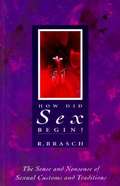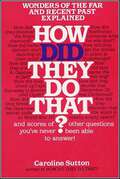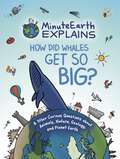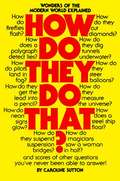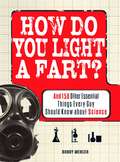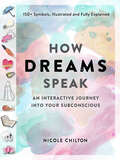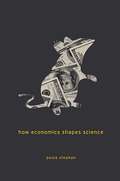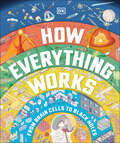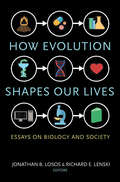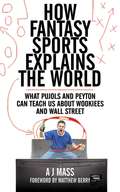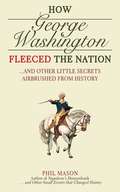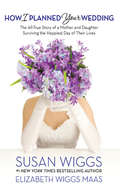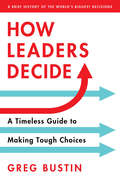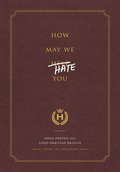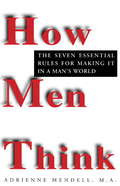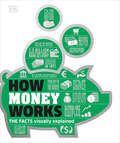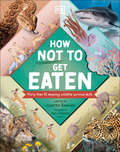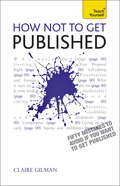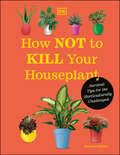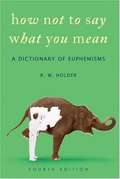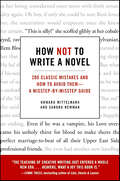- Table View
- List View
How Did Sex Begin?
by R. BraschWitty, candid investigation of the myths, traditions and practices surrounding this most popular of human pursuits, originally published in Australia in 1973. The author has written 30 books including 'How did Sport Begin?' and 'There's a Reason for Everything'. He is a scholar in the fields of theology, philosophy and history and was awarded the Media Peace prize in 1979.
How Did They Do That?
by Caroline SuttonThe totally satisfying answers to more than 100 questions that drive normal people—not to mention infomaniacs and trivia buffs—crazy.Questions about matters great and small, from ancient times to yesterday.Illustrated with illuminating technical drawings and unusual vintage photographs.How did they spend $40 million making Heaven's Gate?How did they decide the length of a mile?How did Beethoven compose when he was deaf?How did they discover the Hope diamond?How did they know the size of the Earth over 1,700 years before anyone sailed around it?How did they set the price of the Louisiana Purchase?How did the FBI devise the "Ten Most Wanted" list?How did they decide which horses were Thoroughbreds?How did they pick the Four Hundred?How did they start the Guiness Book of World Records?How did the Indians decide that cows were sacred?How did they discover penicillin?How did they build the Great Pyramid at Giza?How did they decide how tall to make the Empire State Building?How did they know there was an El Dorado?How did they start the Chicago fire of 1871?How did Hannibal cross the Alps?
How Did Whales Get So Big?: & Other Curious Questions about Animals, Nature, Geology, and Planet Earth (MinuteEarth Explains)
by MinuteEarthSTEM for Kids ― Fun for Kids (Ages 8-10)#1 New Release in Children's Books: Environment & Ecology, Atlases, Anatomy, and Earthquake & VolcanoIn their debut illustrated science book for kids, the team behind the popular YouTube channel MinuteEarth answers all of your child’s wackiest questions about animals, nature, and science alongside engaging images of the natural world.From the scientists, writers, and illustrators at MinuteEarth. Have you ever wondered where Earth’s water came from? Or why leaves change color in the fall? Entertain and educate your kids with fun facts about animals, nature and the wonders of the earth.Amazing STEM for kids, explained simply. With over 300 million views, MinuteEarth simplifies such serious subjects as geology, ecology and biology making them fun for kids. Featuring their signature puns and fun illustrations, this first book in the MinuteEarth Explains series explores topics ranging from weird animal facts to extreme weather, making science for kids enjoyable and unforgettable.Curious questions about our awesome planet. Whether your child is obsessed with the wonder of nature, can’t learn enough interesting facts about animals, or is fascinated by volcanoes, MinuteEarth Explains captures their imagination and fosters an interest in animals, the Earth, and ocean life! By combining humor with rigorous research, this book provides fun facts about animals, nature, science and more in an equally engaging and informative way for kids.MinuteEarth Explains captivates kids with answers to:Why do some animals get gigantic?Why do rivers curve?Can plants talk?How much food is there on earth?And more!If you’re looking for nature books for kids (8-10) or earth science books for kids―or if your child loves books such as The Big Book of Birds, Why?: 1,111 Answers to Everything, or The Wondrous Workings of Planet Earth―then your whole family will love this debut book by MinuteEarth!
How Different From Us: A Biography of Miss Buss and Miss Beale (Routledge Library Editions: Education)
by Josephine KammFrances Mary Buss, who began her teaching career at fourteen, was only twenty-three when she founded the North London Collegiate School, the forerunner and model of Girls’ High Schools throughout the country. Her friend Dorothea Beale was for nearly fifty years Principal of Cheltenham Ladies College, which she changed from an insignificant local school into a school and college with a comprehensive teacher training department and with upwards of a thousand pupils. She was also the founder of St.Hilda’s College, Oxford. Imbued with strong religious principles and endowed with immense energy and industry, the two women exercised a powerful influence on the development of women’s education in Britain. Yet both had to contend with bitter opposition and disillusionment. This is the first joint biography of Miss Buss and Miss Beale and it gives a fascinating comparison of their methods and widely differing characters. The author had access to hitherto unpublished material, and gathered information from pupils of both schools and from others who knew the two headmistresses, ensuring that the book, whilst full of anecdotes, is also authoritative.
How Do They Do That?
by Caroline SuttonHOW DO THEY DO THAT?How do they make mirrors?How do sword swallowers swallow swords?How does a Polaroid picture develop in broad daylight?How do camels go without water?How do they splice genes?How do they create spectacular fireworks?How indeed?Ever found yourself wide-eyed at the wonders of science? Awestruck by the arts? Mystified by the miracles of nature or the marvels of technology?Relief is at hand. Within these pages answers abound. How Do They Do That? clarifies what used to mystify. It explains the inexplicable and makes known the unknown.Here is a book for both the mildly curious and the grand inquisitor. Take a few hours or take a few minutes to browse through this repository of riddles revealed. You'll discover that it's not hocus-pocus that put the whole pear in the bottle of pear brandy or sorcery that suspends a suspension bridge. But if not by magic, how do they do that?The answer awaits within. A questioner's cure, an anodyne of answers, How Do They Do That? is a puzzler's paradise.Caroline Sutton, a graduate of Wesleyan University, fives in New York City, where she writes and edits for the Hilltown Press.
How Do You Light a Fart?
by Bobby MercerFireworks and grenades.Grills and campfires. Burps and farts. Men get a kick out of things that go boom, things that cook with fire, and all forms of bodily gas. What they might not know is that science is what makes it all happen. This book answers all the questions guys have about their favorite topics, such as: How do you make a Lifesaver spark? How do you hotwire a car? Why do kegs float? What is PMS? Why doesn't a cell phone work in metal buildings? Serious science mixed with outrageous humor, this book promises guys the need-to-know info on sports, cars, technology, women, bodily functions, food, and more!
How Do You Light a Fart?: And 150 Other Essential Things Every Guy Should Know about Science
by Bobby MercerFireworks and grenades. Grills and campfires. Burps and farts.Men get a kick out of things that go boom, things that cook with fire, and all forms of bodily gas. What they might not know is that science is what makes it all happen. This book answers all the questions guys have about their favorite topics, such as:How do you make a Lifesaver spark?How do you hotwire a car?Why do kegs float?What is PMS?Why doesn't a cell phone work in metal buildings? Serious science mixed with outrageous humor, this book promises guys the need-to-know info on sports, cars, technology, women, bodily functions, food, and more!
How Do You Light a Fart?
by Bobby MercerFireworks and grenades. Grills and campfires. Burps and farts. Men get a kick out of things that go boom, things that cook with fire, and all forms of bodily gas. What they might not know is that science is what makes it all happen. This book answers all the questions guys have about their favorite topics, such as: How do you make a Lifesaver spark? How do you hotwire a car? Why do kegs float? What is PMS? Why doesn't a cell phone work in metal buildings? Serious science mixed with outrageous humor, this book promises guys the need-to-know info on sports, cars, technology, women, bodily functions, food, and more!
How Dreams Speak: An Interactive Journey into Your Subconscious (150+ Symbols, Illustrated and Fully Explained)
by Nicole ChiltonUnlock the mysteries! What does it mean to dream about a doll? Perhaps your inner child needs to come out and play. Or what if you find yourself flying high above the earth? It&’s your sleeping mind urging your waking mind to look to the future and think about your deepest aspirations. Richly illustrated in watercolor and with explanations and intuitive prompts throughout, How Dreams Speak is a unique visual dream interpretation guide that demystifies over 150 universal symbols and themes. With this book in hand, you&’ll learn the history of dream interpretation and the science of dreaming and be guided through the practice of remembering—then untangling—your nightly adventures. Our dreams speak to us, and within these pages lies the gifts of being able to listen to what our subconscious mind is saying.
How Economics Shapes Science
by Paula StephanAt a time when science is seen as an engine of economic growth, Paula Stephan brings a keen understanding of the cost-benefit calculations made by individuals and institutions as they compete for resources and reputation in scientific fields. She highlights especially the growing gap between the biomedical sciences and physics/engineering.
How Everything Works
by DKDiscover an all-in-one encyclopedia that takes you on an explanatory tour of the world from your own body to outer space.Have you ever wondered how an email gets to someone on the other side of the world in just a few seconds or why it&’s a bad idea to stand under a tree during a thunderstorm? Discover the answers to all these questions and more with these mind-boggling how things work books for children aged 9 and above!Each page of this mind-blowingly detailed and ambitious encyclopedia will guide you through the natural world and the technology that surrounds you. Giant, page-filling illustrations take objects apart – or take the roofs and walls off buildings – to show you how they work, explaining both basic principles (such as photosynthesis) as well as broader concepts (like how all the living things in a rainforest interact). Explore each and every page of this engaging how things work book to discover:- Key insights into both the natural and human worlds- Striking photography that brings certain concepts to life- A diverse range of chapters coinciding with STEM subjects at school In this how things work encyclopedia, chapters range from the human body to cities and industry, to planet Earth, taking in sleep patterns, cooking, sewage systems, wind farms, fungi spores, and plate tectonics along the way. How Everything Works is perfect for children studying STEM subjects at school or anyone who is simply curious about how nature and the modern world work.
How Evolution Shapes Our Lives: Essays on Biology and Society
by Richard E. Lenski Jonathan B. LososIt is easy to think of evolution as something that happened long ago, or that occurs only in "nature," or that is so slow that its ongoing impact is virtually nonexistent when viewed from the perspective of a single human lifetime. But we now know that when natural selection is strong, evolutionary change can be very rapid. In this book, some of the world's leading scientists explore the implications of this reality for human life and society. With some twenty-three essays, this volume provides authoritative yet accessible explorations of why understanding evolution is crucial to human life--from dealing with climate change and ensuring our food supply, health, and economic survival to developing a richer and more accurate comprehension of society, culture, and even what it means to be human itself. Combining new essays with essays revised and updated from the acclaimed Princeton Guide to Evolution, this collection addresses the role of evolution in aging, cognition, cooperation, religion, the media, engineering, computer science, and many other areas. The result is a compelling and important book about how evolution matters to humans today.The contributors are Dan I. Andersson, Francisco J. Ayala, Amy Cavanaugh, Cameron R. Currie, Dieter Ebert, Andrew D. Ellington, Elizabeth Hannon, John Hawks, Paul Keim, Richard E. Lenski, Tim Lewens, Jonathan B. Losos, Virpi Lummaa, Jacob A. Moorad, Craig Moritz, Martha M. Muñoz, Mark Pagel, Talima Pearson, Robert T. Pennock, Daniel E. L. Promislow, Erik M. Quandt, David C. Queller, Robert C. Richardson, Eugenie C. Scott, H. Bradley Shaffer, Joan E. Strassmann, Alan R. Templeton, Paul E. Turner, and Carl Zimmer.
How Fantasy Sports Explains the World
by Aj Mass Matthew BerryThe world of fantasy sports is no longer the purview of nerds and stat geeks. In fact, versions of the game are currently played by tens of millions of people worldwide. But while fantasy sports may have begun as a light-hearted diversion, to many of its participants winning or losing is no laughing matter. The book takes readers on a journey from the casinos of Atlantic City to charred Connecticut campgrounds, from the Last Supper to the Constitutional Convention that started our country down the road to democracy, from the back rooms of Wall Street to the jury rooms of our judicial system. In doing so, Mass demonstrates that winning fantasy advice can come from anyone and be found almost anywhere-the wit and wisdom of William Shakespeare, the scientific genius of Stephen Hawking, or the futuristic whimsy of a galaxy far, far away. Ultimately, How Fantasy Sports Explains the World is not a book about how to win your fantasy sports league. Instead, it is a collection of conversation starters and hypothetical scenarios that get right to the core of what makes fantasy games so compelling in the high-speed information age: how to process and make use of the bottomless pile of data presented to us on a daily basis.
How George Washington Fleeced the Nation: And Other Little Secrets Airbrushed From History
by Phil MasonOur view of the famous is one-dimensional--leading figures from history are summarized in history textbooks with one or two lines: Churchill the war-time genius, Gandhi the poor ascetic--but nobody is perfect and even the famous have their quirks and hidden secrets. How George Washington Fleeced the Nation reveals the often hilarious, sometimes shocking, and always highly informative foibles of the great and the good. Einstein, the most brilliant man who lived, regularly forgot his shoes and never learned to drive. Hitler possibly has a Jewish ancestor. Picasso avoided paying restaurant bills by doodling on their napkins instead. Prepared to be shocked, amused, and outraged at what they didn't teach you in high school.
How I Planned Your Wedding
by Susan And WiggsBestselling author Susan Wiggs literally wrote the book on happily-ever-after love. But orchestrating her daughter Elizabeth's real-world wedding turned into a different story altogether, and one that takes two to tell-the mother and the bride.Here is the all-too-true tale of a mother and daughter collaborating on life's ultimate celebration-a dream wedding. Often poignant, sometimes irreverent and always hilarious, this charming book is also packed with useful advice from both ends of the cupcake-tasting table. Join mother and daughter as they wade through the trenches of flowers and favors, grueling gown decisions...and the cold, cruel realities of a budget. With luck, love and loads of patience, they come out on the other side, bloodied but unbowed, replete with life lessons-and closer than ever before.
How Leaders Decide: A Timeless Guide to Making Tough Choices
by Greg Bustin"Greg's collection of the best and worst decisions in history is a practical, nuanced and timeless guide for today's decision-makers."—Mark Schortman, Chairman, Coca-Cola Bottlers Sales & Services, LLC Can today's leaders look to history when making tough decisions?Whether you're running a small team or an international enterprise, all leaders know the feeling of facing a tough choice. It's impossible to see into the future to predict how our decisions play out, but we can look to the momentous decisions of the past for insights on how profound choices are made. Each decision made by influential figures, from Alfred Nobel and Marie Curie to Martin Luther King, Jr., and The Beatles, have shaped our world—and now they can help you make the decisions that will determine the direction of your organization.Guiding you through fifty-two dramatic historical events and decisions that changed the course of our world, How Leaders Decide challenges decision-makers with provocative ideas and leadership lessons that will propel your business forward. Greg Bustin's well-researched and inspiring stories of high-stakes turning points in history and the leaders that made the final call will help you make sure your next decision is the one that changes everything. How Leaders Decide is an essential book for readers of Start with Why and Leaders Eat Last!Additional Praise for How Leaders Decide:"Exceptional leaders are lifelong learners, and Greg has collected, organized and presented these leadership lessons to stimulate learning, inform decision-making, and inspire action. This is a book that all teams and business leaders should read."—Elizabeth Bryant, Chief Learning Officer, Southwest Airlines"Talk about the perfect combination! In How Leaders Decide, Greg Bustin combines fascinating history with succinct leadership insights to showcase 52 of the greatest leadership decisions the world has seen"—Gordon Leidner, author of The Leadership Secrets of Hamilton
How May We Hate You?
by Todd Dakotah Briscoe Anna DrezenMost people think hotel employees are effortlessly cheerful, naturally helpful, and genuinely like their work. Most people are wrong. Find out what really goes on in the world of hospitality with this hilarious book full of funny and absurd stories, anecdotes told in dialogue, factoids, and hoax pop quizzes by two veteran concierges who paid their way while working at a combined 50 hotels in and around Times Square. They are very pleased to help you learn: · The Truth About Bed Bugs · The Mythology of "Loyalty Programs" · The 411 on Hotel Residents · And so much more Filled with photographs and infographics, How May We Hate You? is both romp and commentary on the hospitality industry and life behind the nametag.
How Men Think
by Adrienne Mendell"An interesting tool for working with gender differences."--John GrayAuthor of Men Are From Mars, Women Are From VenusMen at work do it all the time: They brag, cover up their mistakes, pretend to know what they don't, start fights. And they still get ahead! Why? As psychologist Adrienne Mendell learned when she interviewed one-hundred male executives, the traits that women spend their entire lives erasing from their personalities are actually the qualities that men value in the world of work. And since men are still in the power positions, if you don't play it their way, you don't play at all.Based on Mendell's interviews and her experience of counseling hundreds of frustrated career women, How Men Think identifies the seven rules that men learned by playing sports as children--games that excluded girls. These rules may seem simple on the surface, but understanding them as men do is anything but easy. You may have fallen into many of these traps yourself:* You're mad because you want your male boss to let you control your projects. But you've got to take control--that's the only way you'll get it.* You're steamed because a male colleague consistently takes credit for your work. Do you make a point of touting your accomplishments?* When you make a mistake you apologize. But the man you apologize to doesn't think you're polite--he thinks you're admitting incompetence.* A fight with a male colleague leaves you shaken. But the men in your office shout at each other for an hour and then go out for a beer.These are the times that try women's souls! The strategies, insights, and eye-opening advice in How Men Think will help you get along better with the boys and propel you to the top where you belong."The more women have opportunities to play sports the more proficient they will become in competing in this men's world of 'unwritten rules.' To bridge the gap, Mendell's book, How Men Think, is a necessary guide for women working with men."--Diane Everett, Ph.D. Executive Director National Association for Girls and Women in SportFrom the Trade Paperback edition.
How Money Works: The Facts Visually Explained (DK How Stuff Works)
by DKIt makes the world go round, but money can truly be an enigma. DK&’s visual approach breaks new ground. In graphics, charts, and diagrams, How Money Works demystifies processes and answers the hundreds of financial questions we all have.Money facilitates the billions of transactions that take place every day across the globe. Using &‘need to know&’ boxes, step-by-step diagrams, and other eye-catching visuals, How Money Works shows you how this is possible. It explains economic theories, how governments raise and control money, what goes on in the stock exchange, how analysts predict where shares are heading, and many other issues. It busts jargon, explaining terms such as quantitative easing, cash flow, bonds, superannuation, and the open market.This must-have guide to money further features:Key financial concepts in a uniquely visual way, using bold infographics combined with simple, jargon-free language. Genuinely comprehensive, covering every aspect of money – personal, business, and governmental. Defines hundreds of money-related terms, such as cash flow, bonds, superannuation, and the open market. Offers essential basic know-how on everything from managing debt to online fraud. Fully up-to-date, covering topics such as cryptocurrencies (Bitcoin, Litecoin, and others) and quantitative easing. Includes localizable appendix of territory specific reference information.Our forefathers may have used simple bartering to exchange goods and services, but today we depend on complicated financial instruments for pensions, life assurance, mortgages, and more. How Money Works explains how these work, as well as how to avoid on-line fraud and where to invest. With information on the latest forms of funding and currencies such as Bitcoin, this comprehensive book will fast track you to financial literacy and getting the most from your hard-won cash.
How Not to Get Eaten: More than 75 Incredible Animal Defenses (Wonders of Wildlife )
by Josette ReevesFor many animals, life is a constant battle to stay off a predator&’s menu. So they&’ve had to come up with lots of cunning ways to avoid being eaten.From camouflage and color-changing, natural armor, playing dead, great escapes, detachable body parts, and impressive ways of fighting back, the range of survival tactics in the natural world is quite astonishing (and sometimes pretty disgusting). How Not To Get Eaten is a fun introduction to the ingenious antipredator strategies in the natural world. Discover how meerkats post sentries to guard their homes and possums play dead, to how mimic octopuses change their shape and bombardier beetles unleash a chemical weapon attack. Perfect for children aged 7–9, the book is filled with intriguing illustrations and spectacular photographs of the amazing, obscure, and incredibly strange. You'll never look at nature the same way again!
How NOT to Get Published: Teach Yourself
by Claire GillmanThere are many brilliant books out there, which have not been published because theirauthor has not been able to successfully navigate the minefield that is finding a publisher. In many cases, authors make basic mistakes in their submissions, which ensure that they do not even get read by the correct person. Even if they do reach someone with decision-making power, they often fail to clearly explain the proposition of their book, or the target market.Claire Gilman is the perfect person to help you find a publisher for your manuscript. Shehas done it successfully, having had twenty of her own books published. She has spokento many commissioning editors and agents about what they look for (and look to avoid) in a submission. And she has worked as a literary consultant, helping all sorts of authors to improve their proposals. Now, she combines all this wisdom into one book, explaining clearly 50 common mistakes which authors make, and how you can avoid them and ensure that your work receives the attention and the publisher that it deserves.
How NOT to Get Published: Fifty mistakes to avoid if you want to publish your creative writing
by Claire GillmanThere are many brilliant books out there, which have not been published because theirauthor has not been able to successfully navigate the minefield that is finding a publisher. In many cases, authors make basic mistakes in their submissions, which ensure that they do not even get read by the correct person. Even if they do reach someone with decision-making power, they often fail to clearly explain the proposition of their book, or the target market.Claire Gilman is the perfect person to help you find a publisher for your manuscript. Shehas done it successfully, having had twenty of her own books published. She has spokento many commissioning editors and agents about what they look for (and look to avoid) in a submission. And she has worked as a literary consultant, helping all sorts of authors to improve their proposals. Now, she combines all this wisdom into one book, explaining clearly 50 common mistakes which authors make, and how you can avoid them and ensure that your work receives the attention and the publisher that it deserves.
How Not to Kill Your Houseplant New Edition: Survival Tips for the Horticulturally Challenged
by Veronica PeerlessHow to keep alive 119 gorgeous indoor plants, then help them bloom and thrive.You&’ve welcomed a plant into the home: Now what? Your first job is to keep it alive, then after that help it bloom and thrive. Learn all the tips and tricks you need to become a proud plant parent—of more than 100 different plants (if you&’re up for it)!Yellowed leaves, drooping leaves, dried leaves, even though you've watered it: What&’s going on? How Not to Kill Your Houseplant will explain—and fix—your houseplant woes. Learn to spot the danger signs and take the proper action to rescue your sick plant. Follow quick tips to understand what your plant does and doesn't like: how much light, water, food, heat, and humidity.Discover the perfect plant for your unique space and needs. Bathrooms, cold rooms, at a desk, on a windowsill, or in a gloomy corner or hot suntrap—there are plants for every location to create your own indoor oasis.This is your guide to every stage of plant parenting for beginners, from identifying exactly what's in the pot to keeping it in check when it grows too well!
How Not to Say What You Mean: A Dictionary of Euphemisms
by R. W. HolderThe third edition of this dictionary updates each entry with the latest usage. The entry for each euphemism includes its definition, the original meaning of the term, and quotations with the term. A thematic index is included, which confirms the use of euphemisms to refer to taboo subjects in a prudish society. Holder, who lives in England, has written the dictionary for an English-speaking audience, and British usage predominates. Those examples used mainly in the US or Scotland are noted as such. Annotation (c)2003 Book News, Inc., Portland, OR (booknews.com)
How Not to Write a Novel: 200 Classic Mistakes and How to Avoid Them—A Misstep-by-Misstep Guide
by Howard Mittelmark Sandra Newman"What do you think of my fiction book writing?" the aspiring novelist extorted. "Darn," the editor hectored, in turn. "I can not publish your novel! It is full of what we in the business call 'really awful writing.'" "But how shall I absolve this dilemma? I have already read every tome available on how to write well and get published!" The writer tossed his head about, wildly."It might help," opined the blonde editor, helpfully, "to ponder how NOT to write a novel, so you might avoid the very thing!"Many writing books offer sound advice on how to write well. This is not one of those books. On the contrary, this is a collection of terrible, awkward, and laughably unreadable excerpts that will teach you what to avoid—at all costs—if you ever want your novel published. In How Not to Write a Novel, authors Howard Mittelmark and Sandra Newman distill their 30 years combined experience in teaching, editing, writing, and reviewing fiction to bring you real advice from the other side of the query letter. Rather than telling you how or what to write, they identify the 200 most common mistakes unconsciously made by writers and teach you to recognize, avoid, and amend them. With hilarious "mis-examples" to demonstrate each manuscript-mangling error, they'll help you troubleshoot your beginnings and endings, bad guys, love interests, style, jokes, perspective, voice, and more. As funny as it is useful, this essential how-NOT-to guide will help you get your manuscript out of the slush pile and into the bookstore.
